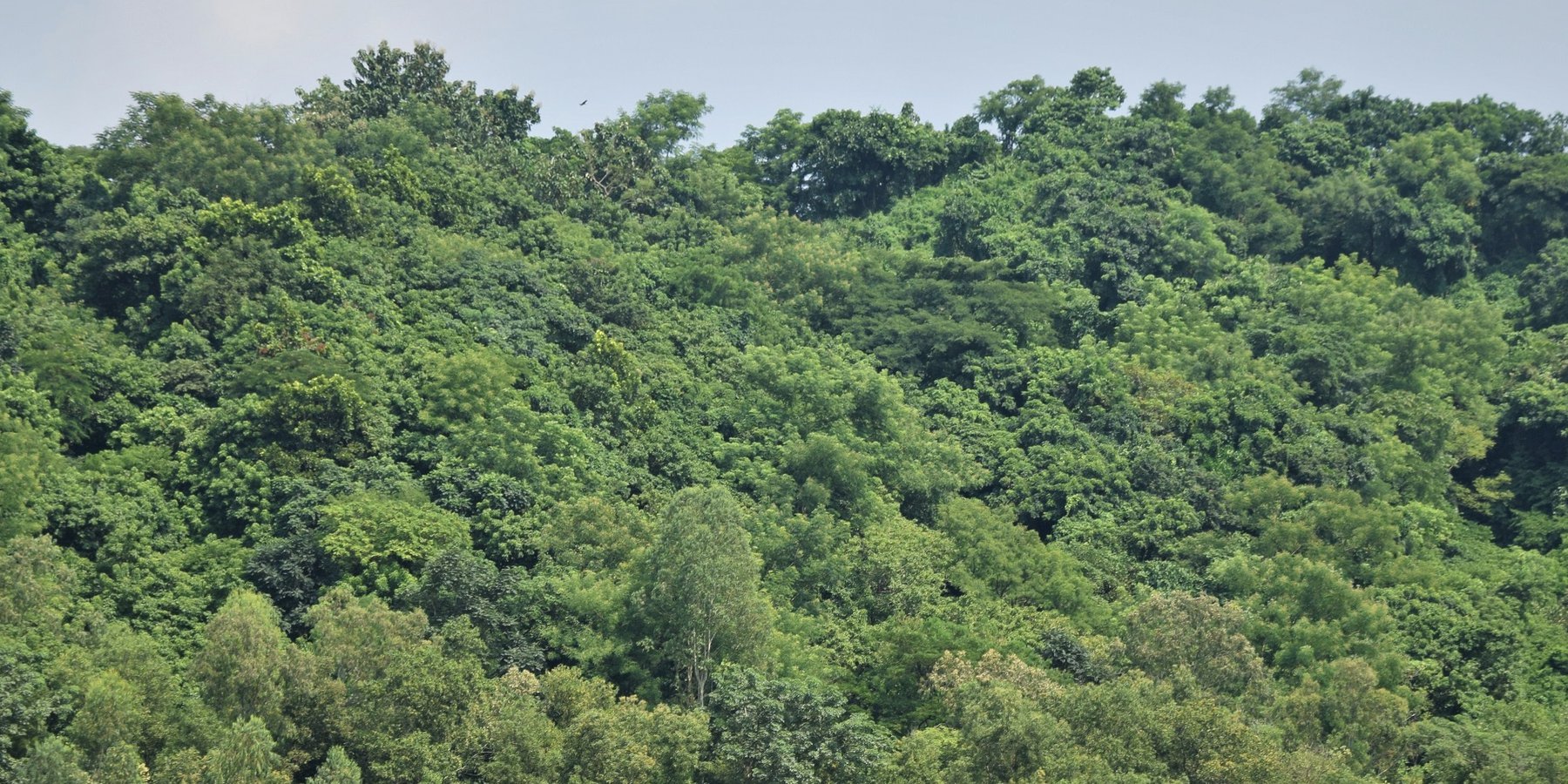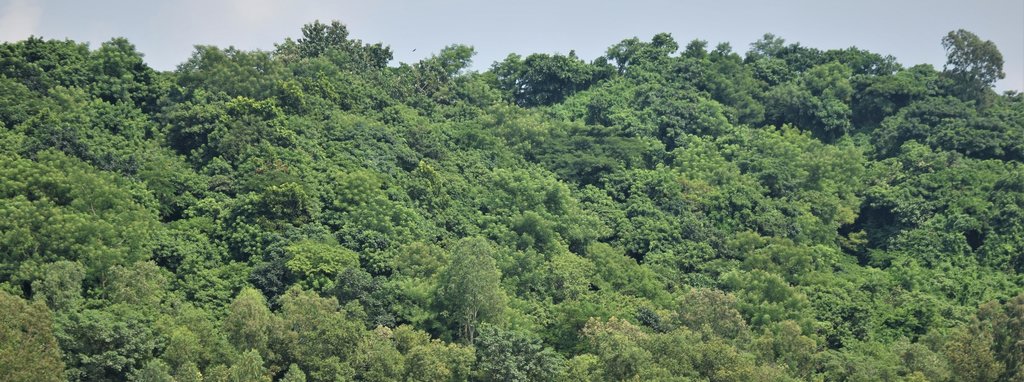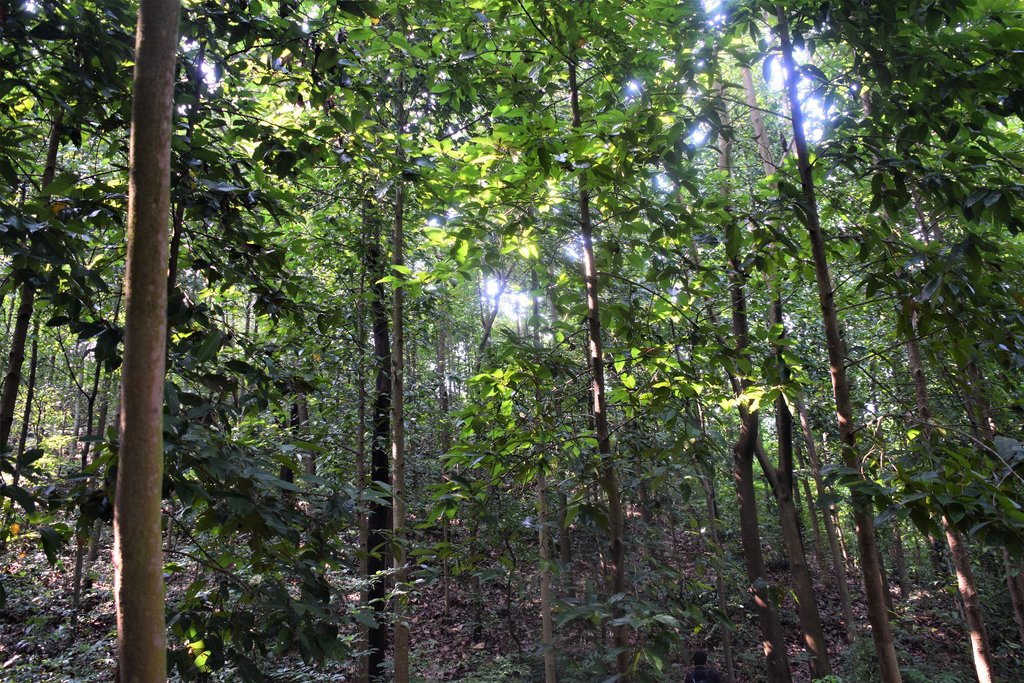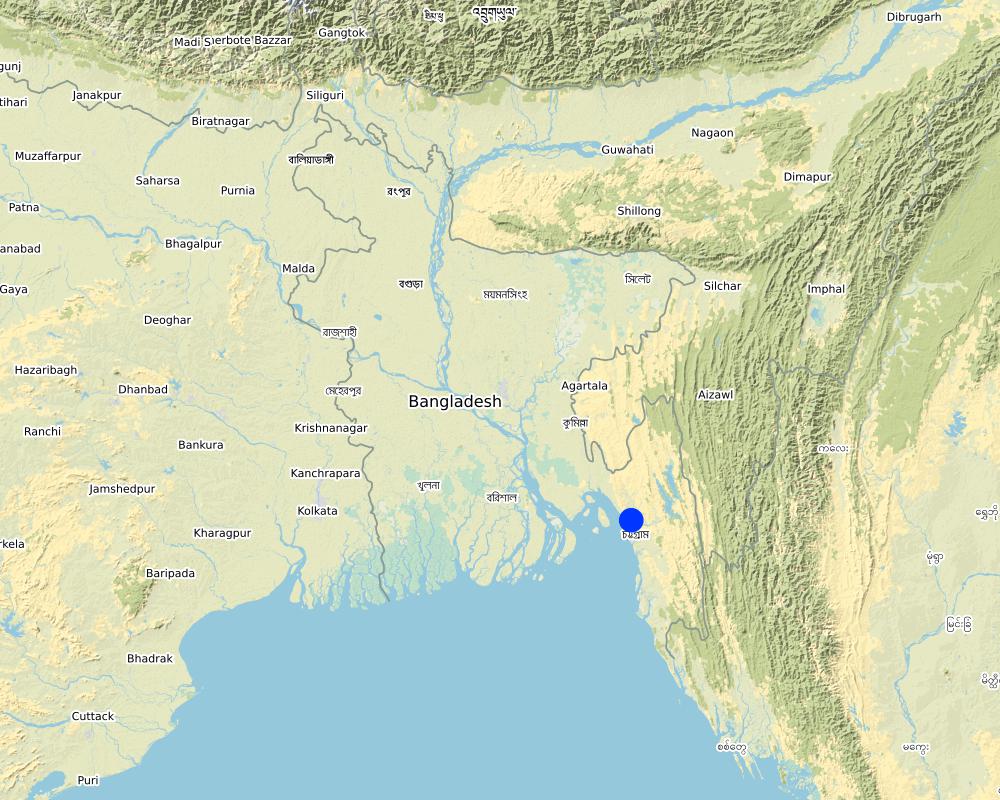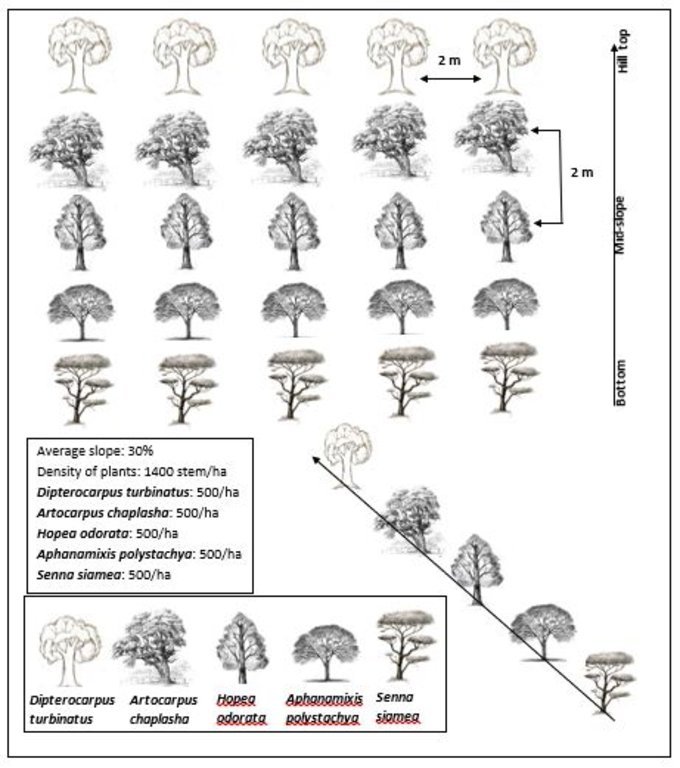Mixed plantation with slow growing indigenous species to protect land degradation [Bangladesh]
- Creation:
- Update:
- Compiler: Fazlay Arafat
- Editor: –
- Reviewers: Nicole Harari, Rima Mekdaschi Studer, Ursula Gaemperli
Desi Projatir Misro Bagan
technologies_4329 - Bangladesh
View sections
Expand all Collapse all1. General information
1.2 Contact details of resource persons and institutions involved in the assessment and documentation of the Technology
Key resource person(s)
land user:
Hossain Md. Akhter
Institute of Forestry and Environmental Sciences, University of Chittagong
Bangladesh
land user:
Alam Md. Bodiul
University of Chittagong
Bangladesh
Name of project which facilitated the documentation/ evaluation of the Technology (if relevant)
Decision Support for Mainstreaming and Scaling out Sustainable Land Management (GEF-FAO / DS-SLM)Name of the institution(s) which facilitated the documentation/ evaluation of the Technology (if relevant)
Bangladesh Forest Department (Bangladesh Forest Department) - Bangladesh1.3 Conditions regarding the use of data documented through WOCAT
The compiler and key resource person(s) accept the conditions regarding the use of data documented through WOCAT:
Ja
1.4 Declaration on sustainability of the described Technology
Is the Technology described here problematic with regard to land degradation, so that it cannot be declared a sustainable land management technology?
Nee
2. Description of the SLM Technology
2.1 Short description of the Technology
Definition of the Technology:
Mixed plantation technique with slow growing indigenous plant species in hill slope, that plays an important role to protect land degradation.
2.2 Detailed description of the Technology
Description:
Mixed-species plantations can play an important role in regulating land degradation and sustainable management of degraded forest areas. Among the various forestry practices, planting fast-growing species (used in mono-culture plantation) with slow-growing and indigenous species has a positive long-term impact on forest land management. Mixed species tree plantations have the potential to improve forest soils, forest cover and biological diversity, and facilitate forest succession in degraded ecosystems. In addition to carbon accumulation, mixed plantations also increase understory plant regeneration, and in some cases, reduce diseases and pests infestation in plantation. This technology is applied in hill-forest areas in Bangladesh for preventing erosion and risk of landslides, and to provide a sustainable supply of timber and fuel wood.
The plantation site located in Hathazari area of Chittagong division and inside the periphery of University of Chittagong. The landform is hill slope with 16-30% slopes on average. The annual rainfall is around 2500 mm and the soil texture is loamy to silty. The species used at the Hathazari plantation site were: Garjan (Dipterocarpus turbinatus), Telsur (Hopea odorata), Chapalish (Artocarpus chaplasha), Pithraj (Aphanamixis polystachya), and Minjiri (Senna siamea). All are deep-rooted, slow growing indigenous plant species with a felling rotation of 25-30 years. The Dipterocarpus species grows well on top of hill whereas Artocarpus chaplasha and Hopea odorata grows well in mid slope. Aphanamixis polystachya and Senna siamea perform well in bottom layer of hill. The sequence has positive mutual effects on tree growing. The plantation was established and managed by the authority of University of Chittagong (owner of the land) in 1990 with 2500 trees planted per hectare area (spacing interval 2m x 2m). The average slope of the site is around 30%. Before reforestation, the land was degraded and unproductive. As only a few scattered trees grow due to a huge demand of fuel wood the resulting insufficient coverage by tree crowns frequently led to landslides in the area. The local communities are only allowed to collect the dead branches as fuel and other non-wood forest products like honey, mushrooms, fruits and fodders from the plantation site.
The major activities required to establish the plantation are: seed collection, nursery preparation, site preparation, pit preparation, planting, tying of plants to stick for support, application of fertilizer, compost and biocide. After first establishment, the plantation needs ongoing maintenance activities such as weeding, refilling of vacancies, thinning, pruning, application of fertilizers and biocides (if necessary) and cutting of climbers. The timber species undergo a variety of thinning practices before the entire stand reaches maturity. These trees are progressively thinned out to provide fuel wood and timber, while allowing room for the natural regeneration of native species. The university authority carried out the maintenance activities and such a practice is advantageous to adjacent local communities since it meets their fuel wood demand.
Prior to establishment of the plantation, the area was barren and unproductive, and was hardly a suitable habitat for wildlife. More critically, during the annual monsoons, landslides were a regular phenomenon. The natural regeneration of the deforested area was additionally hampered by incendiary fires set by local communities for agricultural purpose. After the establishment of the plantation and the subsequent improvement of forest/land cover, it is now a habit for various species of bird, monkeys, deer, wild pigs, and rabbits. Furthermore, in humid tropical regions like Bangladesh, the frequent litterfall from indigenous plant species in mixed plantations constitutes the bulk of soil organic matter, and improved nutrient availability and soil fertility.
Though the mixed plantation required intensive management in the early stage, the example of this plantation shows that the mixed plantation with indigenous species is worthwhile and a degraded area can fully recover after 20 years. However, illicit felling of timber trees and illegal removal of litters from the ground for fuel by the local communities are still remains as a management challenge. The practice retains ecological integrity and enhances human well-being (through ‘cultural’ ecosystem services such as aesthetic beauty, ecotourism etc.) and livelihood (timber, fuelwood, non-timber forest products) as well.
2.3 Photos of the Technology
2.5 Country/ region/ locations where the Technology has been applied and which are covered by this assessment
Country:
Bangladesh
Region/ State/ Province:
Chittagong division
Further specification of location:
Hathazari
Specify the spread of the Technology:
- evenly spread over an area
If precise area is not known, indicate approximate area covered:
- 0.1-1 km2
Is/are the technology site(s) located in a permanently protected area?
Nee
Map
×2.6 Date of implementation
Indicate year of implementation:
1990
2.7 Introduction of the Technology
Specify how the Technology was introduced:
- during experiments/ research
3. Classification of the SLM Technology
3.1 Main purpose(s) of the Technology
- improve production
- reduce, prevent, restore land degradation
- conserve ecosystem
- reduce risk of disasters
- create beneficial social impact
3.2 Current land use type(s) where the Technology is applied
Land use mixed within the same land unit:
Nee

Forest/ woodlands
- Tree plantation, afforestation
Tree plantation, afforestation: Specify origin and composition of species:
- Mixed varieties
Type of tree plantation, afforestation:
- tropical rain forest plantation
- Garjan (Dipterocarpus turbinatus), Telsur (Hopea odorata), Chapalish (Artocarpus Chaplasha), Pithraj (Aphanamixis polystachya), Minjiri (Senna siamea), etc.
Are the trees specified above deciduous or evergreen?
- mixed deciduous/ evergreen
Products and services:
- Timber
- Fuelwood
- Nature conservation/ protection
- Recreation/ tourism
- Protection against natural hazards
3.3 Has land use changed due to the implementation of the Technology?
Has land use changed due to the implementation of the Technology?
- Yes (Please fill out the questions below with regard to the land use before implementation of the Technology)
Land use mixed within the same land unit:
Nee

Unproductive land
Specify:
The area was unproductive with some scatter trees that grows naturally. Due to huge demand of fuel wood the few natural stands also faced tremendous pressure. As the canopy coverage was exposed, landslides occurred frequently in that area.
3.4 Water supply
Water supply for the land on which the Technology is applied:
- rainfed
3.5 SLM group to which the Technology belongs
- forest plantation management
- improved ground/ vegetation cover
- ecosystem-based disaster risk reduction
3.6 SLM measures comprising the Technology

vegetative measures
- V1: Tree and shrub cover
3.7 Main types of land degradation addressed by the Technology

soil erosion by water
- Wt: loss of topsoil/ surface erosion
- Wg: gully erosion/ gullying
- Wm: mass movements/ landslides
3.8 Prevention, reduction, or restoration of land degradation
Specify the goal of the Technology with regard to land degradation:
- reduce land degradation
4. Technical specifications, implementation activities, inputs, and costs
4.1 Technical drawing of the Technology
Technical specifications (related to technical drawing):
The dimensions of structures are explained in the description part.
Author:
Md. Fazlay Arafat
Date:
13/09/2018
4.2 General information regarding the calculation of inputs and costs
Specify how costs and inputs were calculated:
- per Technology area
Indicate size and area unit:
hectare
If using a local area unit, indicate conversion factor to one hectare (e.g. 1 ha = 2.47 acres): 1 ha =:
2.47 acres
other/ national currency (specify):
BDT
If relevant, indicate exchange rate from USD to local currency (e.g. 1 USD = 79.9 Brazilian Real): 1 USD =:
83.0
Indicate average wage cost of hired labour per day:
500
4.3 Establishment activities
| Activity | Timing (season) | |
|---|---|---|
| 1. | Nursery preparation (seed collection, site clearing, leveling and fencing, drainage arrangement, bed preparation, making overhead shed, poly-bag preparation, potting seeds, manuring, irrigation, weed control) | October |
| 2. | Site preparation (prepare plantation site map with GPS, jungle cutting, debris collection and staging, preparation of inspection paths and fire lines) | May |
| 3. | Plantation (pit preparation, tying up of plants, application of fertilizers, compost and biocide, stick for support) | June-July |
4.4 Costs and inputs needed for establishment
| Specify input | Unit | Quantity | Costs per Unit | Total costs per input | % of costs borne by land users | |
|---|---|---|---|---|---|---|
| Labour | Nursery work | Person day | 32.0 | 500.0 | 16000.0 | 100.0 |
| Labour | Site preparation | Person day | 20.0 | 500.0 | 10000.0 | 100.0 |
| Labour | Plantation | Person day | 40.0 | 500.0 | 20000.0 | 100.0 |
| Equipment | Polybags | Pieces | 3000.0 | 1.0 | 3000.0 | 100.0 |
| Equipment | Loamy soil | Cubic meter | 6.0 | 400.0 | 2400.0 | 100.0 |
| Equipment | Bamboo | Pieces | 7.0 | 600.0 | 4200.0 | 100.0 |
| Equipment | Stick | Pieces | 2600.0 | 2.0 | 5200.0 | 100.0 |
| Equipment | Rope | Lump sum | 1.0 | 200.0 | 200.0 | 100.0 |
| Equipment | Bucket, Spade, Knife | Lump sum | 1.0 | 1000.0 | 1000.0 | 100.0 |
| Plant material | Seeds | Kg | 2.0 | 500.0 | 1000.0 | 100.0 |
| Fertilizers and biocides | Urea | Kg | 12.0 | 35.0 | 420.0 | 100.0 |
| Fertilizers and biocides | TSP | Kg | 12.0 | 40.0 | 480.0 | 100.0 |
| Fertilizers and biocides | MoP | Kg | 12.0 | 30.0 | 360.0 | 100.0 |
| Fertilizers and biocides | Compost | Kg | 3200.0 | 4.0 | 12800.0 | 100.0 |
| Fertilizers and biocides | Biocide | Lump Sum | 1.0 | 200.0 | 200.0 | 100.0 |
| Construction material | Signboard (to demarcate plantation area, number of species planted and year of plantation) | Pieces | 1.0 | 1000.0 | 1000.0 | 100.0 |
| Total costs for establishment of the Technology | 78260.0 | |||||
| Total costs for establishment of the Technology in USD | 942.89 | |||||
Comments:
The University of Chittagong is the land user here.
4.5 Maintenance/ recurrent activities
| Activity | Timing/ frequency | |
|---|---|---|
| 1. | 1st year weeding and climber cutting | 3 times in a year |
| 2. | 2nd year weeding, climber cutting and thinning | 3 times in a year |
| 3. | 3rd year weeding, climber cutting, thinning and pruning | 3 times in a year |
| 4. | 1st year Vacancy filling, fertilizer and compost application | June-July |
| 5. | 2nd year Vacancy filling, fertilizer and compost application | June-July |
4.6 Costs and inputs needed for maintenance/ recurrent activities (per year)
| Specify input | Unit | Quantity | Costs per Unit | Total costs per input | % of costs borne by land users | |
|---|---|---|---|---|---|---|
| Labour | 1st year weeding and climber cutting | person-day | 21.0 | 500.0 | 10500.0 | 100.0 |
| Labour | 2nd year weeding, climber cutting and thinning | person-day | 21.0 | 500.0 | 10500.0 | 100.0 |
| Labour | 3rd year weeding, climber cutting, thinning and pruning | person-day | 12.0 | 500.0 | 6000.0 | 100.0 |
| Labour | Vacancy filling, fertilizer and compost application 2 times | person-day | 30.0 | 500.0 | 15000.0 | 100.0 |
| Plant material | Seedlings | pieces | 500.0 | 10.0 | 5000.0 | 100.0 |
| Fertilizers and biocides | Urea, TSP, MoP, Compost | Lump sum | 1.0 | 1000.0 | 1000.0 | 100.0 |
| Total costs for maintenance of the Technology | 48000.0 | |||||
| Total costs for maintenance of the Technology in USD | 578.31 | |||||
4.7 Most important factors affecting the costs
Describe the most determinate factors affecting the costs:
Labor cost
5. Natural and human environment
5.1 Climate
Annual rainfall
- < 250 mm
- 251-500 mm
- 501-750 mm
- 751-1,000 mm
- 1,001-1,500 mm
- 1,501-2,000 mm
- 2,001-3,000 mm
- 3,001-4,000 mm
- > 4,000 mm
Agro-climatic zone
- humid
5.2 Topography
Slopes on average:
- flat (0-2%)
- gentle (3-5%)
- moderate (6-10%)
- rolling (11-15%)
- hilly (16-30%)
- steep (31-60%)
- very steep (>60%)
Landforms:
- plateau/plains
- ridges
- mountain slopes
- hill slopes
- footslopes
- valley floors
Altitudinal zone:
- 0-100 m a.s.l.
- 101-500 m a.s.l.
- 501-1,000 m a.s.l.
- 1,001-1,500 m a.s.l.
- 1,501-2,000 m a.s.l.
- 2,001-2,500 m a.s.l.
- 2,501-3,000 m a.s.l.
- 3,001-4,000 m a.s.l.
- > 4,000 m a.s.l.
Indicate if the Technology is specifically applied in:
- not relevant
5.3 Soils
Soil depth on average:
- very shallow (0-20 cm)
- shallow (21-50 cm)
- moderately deep (51-80 cm)
- deep (81-120 cm)
- very deep (> 120 cm)
Soil texture (topsoil):
- medium (loamy, silty)
Soil texture (> 20 cm below surface):
- medium (loamy, silty)
Topsoil organic matter:
- medium (1-3%)
5.4 Water availability and quality
Ground water table:
5-50 m
Availability of surface water:
medium
Water quality (untreated):
poor drinking water (treatment required)
Water quality refers to:
surface water
Is water salinity a problem?
Nee
Is flooding of the area occurring?
Nee
5.5 Biodiversity
Species diversity:
- medium
Habitat diversity:
- low
5.6 Characteristics of land users applying the Technology
Sedentary or nomadic:
- Sedentary
Market orientation of production system:
- mixed (subsistence/ commercial)
Off-farm income:
- less than 10% of all income
Relative level of wealth:
- average
Individuals or groups:
- employee (company, government)
Level of mechanization:
- manual work
Gender:
- women
- men
Age of land users:
- youth
- middle-aged
5.7 Average area of land used by land users applying the Technology
- < 0.5 ha
- 0.5-1 ha
- 1-2 ha
- 2-5 ha
- 5-15 ha
- 15-50 ha
- 50-100 ha
- 100-500 ha
- 500-1,000 ha
- 1,000-10,000 ha
- > 10,000 ha
Is this considered small-, medium- or large-scale (referring to local context)?
- medium-scale
5.8 Land ownership, land use rights, and water use rights
Land ownership:
- state
Land use rights:
- individual
Water use rights:
- open access (unorganized)
Are land use rights based on a traditional legal system?
Nee
5.9 Access to services and infrastructure
health:
- poor
- moderate
- good
education:
- poor
- moderate
- good
technical assistance:
- poor
- moderate
- good
employment (e.g. off-farm):
- poor
- moderate
- good
markets:
- poor
- moderate
- good
energy:
- poor
- moderate
- good
roads and transport:
- poor
- moderate
- good
drinking water and sanitation:
- poor
- moderate
- good
financial services:
- poor
- moderate
- good
6. Impacts and concluding statements
6.1 On-site impacts the Technology has shown
Socio-economic impacts
Production
wood production
forest/ woodland quality
non-wood forest production
Comments/ specify:
honey, mushrooms and fruits for wildlife
risk of production failure
Comments/ specify:
mixed plantation is more pest resistant
product diversity
Comments/ specify:
Along with timber these mixed plantation yields oil, fruits, fodder, fuel and herbal medicines
production area
land management
Comments/ specify:
The degraded land which was vulnerable for landslides now convert to a native plantation area
Water availability and quality
irrigation water availability
Comments/ specify:
Increase of the stream flow that used for irrigation in adjacent crop lands
irrigation water quality
Income and costs
diversity of income sources
Comments/ specify:
tourism promoted in the area
workload
Comments/ specify:
The workload increased at the initial stage but in the long run it will protect from the hassle of landslides
Socio-cultural impacts
land use/ water rights
recreational opportunities
Comments/ specify:
tourism increased in the area
SLM/ land degradation knowledge
Ecological impacts
Water cycle/ runoff
water quantity
Comments/ specify:
water holding capacity of soil increased due to the increase organic matter in the soil and canopy coverage
water quality
surface runoff
excess water drainage
groundwater table/ aquifer
Comments/ specify:
aquifer recharge positively influenced due to the canopy coverage and reduction of surface runoff
Soil
soil moisture
soil cover
soil loss
soil accumulation
nutrient cycling/ recharge
soil organic matter/ below ground C
Biodiversity: vegetation, animals
Vegetation cover
biomass/ above ground C
plant diversity
invasive alien species
Comments/ specify:
as the plantation established and maintained with native plant species, the alien invasive plant species are not able to spread much here
animal diversity
beneficial species
habitat diversity
Comments/ specify:
The before bare, unproductive and degraded land now supports habitat for various wildlife
pest/ disease control
Climate and disaster risk reduction
landslides/ debris flows
impacts of cyclones, rain storms
emission of carbon and greenhouse gases
wind velocity
6.2 Off-site impacts the Technology has shown
water availability
reliable and stable stream flows in dry season
downstream siltation
Comments/ specify:
downstream siltation decreased due to reduction of surface runoff
impact of greenhouse gases
6.3 Exposure and sensitivity of the Technology to gradual climate change and climate-related extremes/ disasters (as perceived by land users)
Gradual climate change
Gradual climate change
| Season | increase or decrease | How does the Technology cope with it? | |
|---|---|---|---|
| annual temperature | increase | well | |
| annual rainfall | decrease | well | |
| seasonal rainfall | wet/ rainy season | increase | well |
Climate-related extremes (disasters)
Biological disasters
| How does the Technology cope with it? | |
|---|---|
| insect/ worm infestation | well |
6.4 Cost-benefit analysis
How do the benefits compare with the establishment costs (from land users’ perspective)?
Short-term returns:
slightly negative
Long-term returns:
very positive
How do the benefits compare with the maintenance/ recurrent costs (from land users' perspective)?
Short-term returns:
slightly negative
Long-term returns:
positive
6.5 Adoption of the Technology
- 1-10%
Of all those who have adopted the Technology, how many did so spontaneously, i.e. without receiving any material incentives/ payments?
- 91-100%
6.6 Adaptation
Has the Technology been modified recently to adapt to changing conditions?
Nee
6.7 Strengths/ advantages/ opportunities of the Technology
| Strengths/ advantages/ opportunities in the land user’s view |
|---|
| This practice reduces 80% of landslides in this area. |
| Increases the soil fertility of the degraded land through improved nutrient cycling. |
| Enhances biodiversity conservation through habitat improvement. |
| Strengths/ advantages/ opportunities in the compiler’s or other key resource person’s view |
|---|
| Increase carbon sequestration |
| Provide a sustainable source of fuel wood and timber to the land user |
6.8 Weaknesses/ disadvantages/ risks of the Technology and ways of overcoming them
| Weaknesses/ disadvantages/ risks in the land user’s view | How can they be overcome? |
|---|---|
| Protecting mixed-species plantations from illicit felling is difficult | Regular patrolling need to be introduced |
| Silvicultural practices like thinning and pruning are not systematically practiced as local community collect dead branches for fuel | |
| Local community collect litter from the ground to meet their fuel demand and this reduces the soil fertility | Collecting litter from ground should be banned to protect soil fertility |
| Weaknesses/ disadvantages/ risks in the compiler’s or other key resource person’s view | How can they be overcome? |
|---|---|
| Due to the slow-growing nature of indigenous plant species, there is a long lag period before harvest gets possible (which has impacts on income). | Alternate income generation activity need to be introduced |
7. References and links
7.1 Methods/ sources of information
- field visits, field surveys
Number of informants were five including the plantation co-coordinator and plantation monitoring officer.
- interviews with land users
Interview of four land user
- interviews with SLM specialists/ experts
One professor and one assistant professor of forestry discipline.
When were the data compiled (in the field)?
11/09/2018
7.4 General comments
The questionnaire addressed all the specifications of the technology
Links and modules
Expand all Collapse allLinks
No links
Modules
No modules


